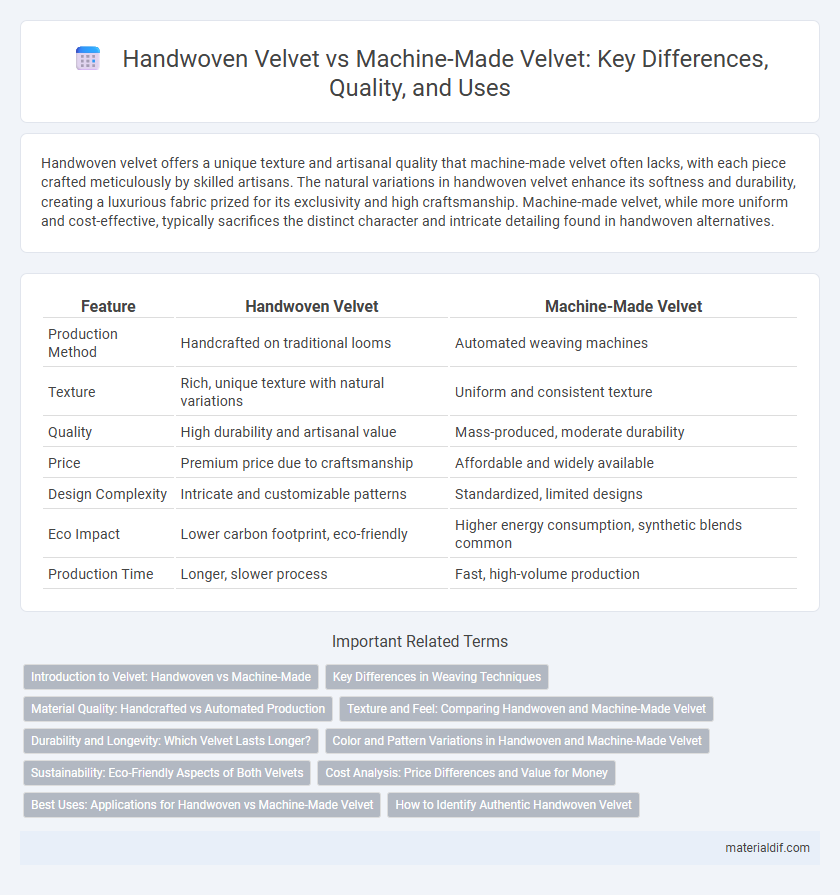Handwoven velvet offers a unique texture and artisanal quality that machine-made velvet often lacks, with each piece crafted meticulously by skilled artisans. The natural variations in handwoven velvet enhance its softness and durability, creating a luxurious fabric prized for its exclusivity and high craftsmanship. Machine-made velvet, while more uniform and cost-effective, typically sacrifices the distinct character and intricate detailing found in handwoven alternatives.
Table of Comparison
| Feature | Handwoven Velvet | Machine-Made Velvet |
|---|---|---|
| Production Method | Handcrafted on traditional looms | Automated weaving machines |
| Texture | Rich, unique texture with natural variations | Uniform and consistent texture |
| Quality | High durability and artisanal value | Mass-produced, moderate durability |
| Price | Premium price due to craftsmanship | Affordable and widely available |
| Design Complexity | Intricate and customizable patterns | Standardized, limited designs |
| Eco Impact | Lower carbon footprint, eco-friendly | Higher energy consumption, synthetic blends common |
| Production Time | Longer, slower process | Fast, high-volume production |
Introduction to Velvet: Handwoven vs Machine-Made
Handwoven velvet is crafted using traditional techniques that create a unique texture and richer depth due to the individual attention given to each thread. In contrast, machine-made velvet is produced at a faster rate with automated looms, offering consistent patterns and wider availability but often lacking the artisanal quality found in handwoven varieties. Choosing between handwoven and machine-made velvet depends on the desired texture, craftsmanship, and application in fashion or interior design.
Key Differences in Weaving Techniques
Handwoven velvet is crafted using traditional techniques that involve manually interlacing threads on a loom, resulting in unique texture variations and a more artisanal look. Machine-made velvet employs automated processes that produce consistent patterns and higher uniformity, allowing for faster production and lower costs. The key difference lies in the tactile quality and craftsmanship, where handwoven velvet tends to have richer texture and durability compared to the precision and scalability of machine-made velvet.
Material Quality: Handcrafted vs Automated Production
Handwoven velvet showcases superior material quality due to meticulous craftsmanship, resulting in denser, richer textures and enhanced durability compared to machine-made velvet. The handwoven process allows artisans to control thread tension and pattern precision, producing unique fabric variations that automated production often lacks. Machine-made velvet, while more uniform and cost-effective, may sacrifice the intricate detail and robust handfeel inherent in handcrafted velvet.
Texture and Feel: Comparing Handwoven and Machine-Made Velvet
Handwoven velvet features a rich, tactile texture with unique variations that result from the artisanal weaving process, offering a luxurious feel distinguished by its depth and softness. Machine-made velvet typically presents a more uniform surface with consistent pile height, providing a smoother but less intricate texture. The subtle irregularities in handwoven velvet enhance its plushness and visual appeal, making it more desirable for high-end upholstery and fashion applications.
Durability and Longevity: Which Velvet Lasts Longer?
Handwoven velvet exhibits superior durability and longevity due to its meticulous craftsmanship and the use of high-quality natural fibers, which allow it to withstand wear and maintain texture over time. Machine-made velvet, while more uniform and cost-effective, often relies on synthetic fibers that may degrade faster and show signs of wear sooner. Choosing handwoven velvet ensures a timeless fabric with enhanced resilience, ideal for long-term use in upholstery and fashion.
Color and Pattern Variations in Handwoven and Machine-Made Velvet
Handwoven velvet features rich, unique color variations and intricate patterns created through skilled craftsmanship, resulting in one-of-a-kind textures and hues that subtly shift with light. Machine-made velvet offers consistent color saturation and repetitive patterns, ideal for large-scale production but lacking the depth and individuality found in handmade textiles. The artisanal process of handweaving allows for customization and complex designs that machine looms cannot perfectly replicate.
Sustainability: Eco-Friendly Aspects of Both Velvets
Handwoven velvet is eco-friendly due to its low energy consumption and minimal chemical use, supporting sustainable artisanal practices. Machine-made velvet, while efficient for mass production, often relies on synthetic fibers and higher water and energy inputs, impacting its environmental footprint. Choosing handwoven velvet promotes reduced carbon emissions and supports sustainable fiber sourcing, making it a greener option compared to conventional machine-made velvet.
Cost Analysis: Price Differences and Value for Money
Handwoven velvet typically commands a higher price due to the labor-intensive craftsmanship and artisanal quality embedded in each piece, resulting in unique texture and durability. Machine-made velvet offers a more affordable option with consistent patterns and faster production but may lack the nuanced detail and long-term resilience of handwoven fabric. Evaluating cost versus value, handwoven velvet justifies its premium through exclusivity and superior hand-feel, while machine-made variants cater to budget-conscious buyers seeking mass availability.
Best Uses: Applications for Handwoven vs Machine-Made Velvet
Handwoven velvet excels in luxury fashion and bespoke upholstery due to its unique texture, exceptional softness, and artisanal craftsmanship that enhances high-end garments and decorative pieces. Machine-made velvet offers durability and cost-effectiveness, making it ideal for mass-produced clothing, commercial furniture, and large-scale interior design projects where consistency and volume are essential. Choosing between handwoven and machine-made velvet depends on the desired level of exclusivity, texture richness, and application scale.
How to Identify Authentic Handwoven Velvet
Authentic handwoven velvet features irregularities in the weave and a more varied pile texture, reflecting the artisan's craftsmanship and time-intensive process. The density and depth of the pile in handwoven velvet are typically richer and more tactile compared to uniform machine-made velvet, which often exhibits a consistent pattern and smoother finish. Examining the selvage edges and subtle color variations under natural light can also help distinguish genuine handwoven velvet from machine-made alternatives.
Handwoven Velvet vs Machine-Made Velvet Infographic

 materialdif.com
materialdif.com